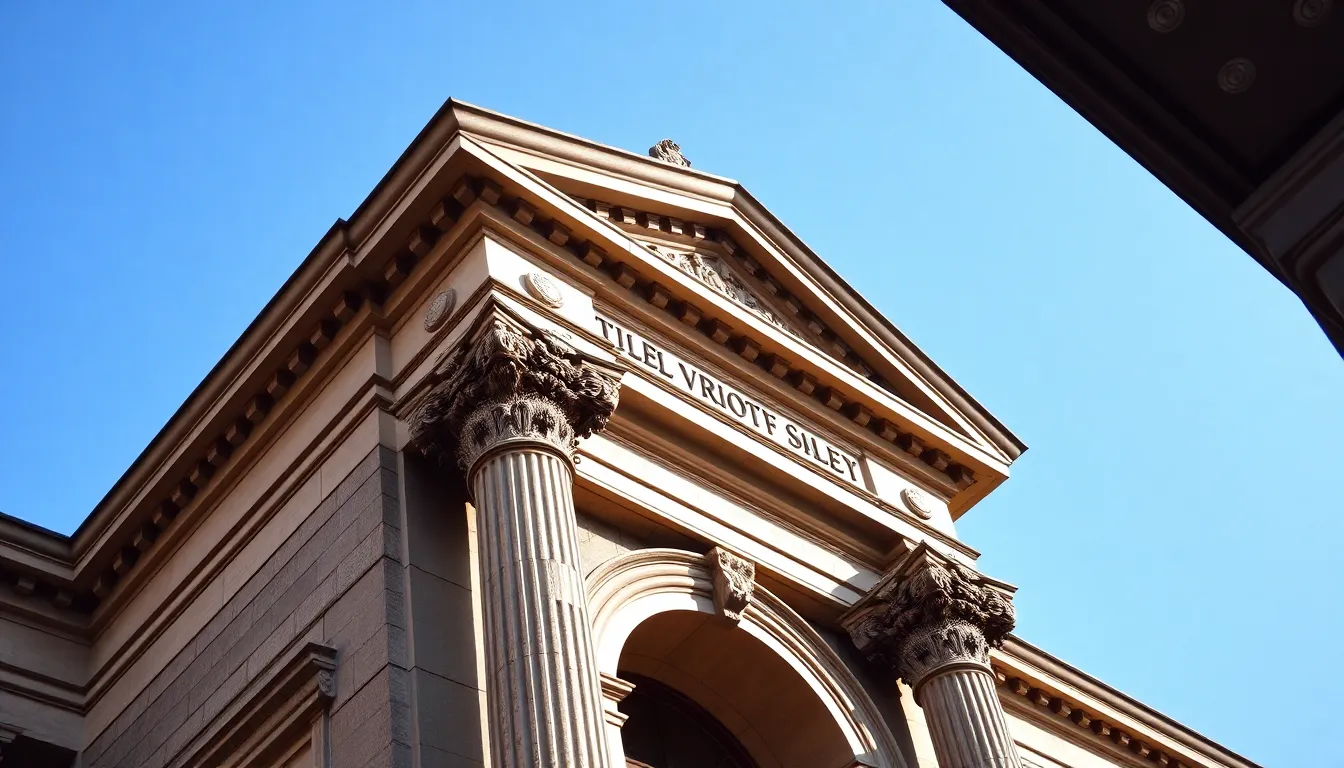Pediment architecture might sound like a fancy term reserved for history buffs and architects, but it’s more accessible than it seems. Picture this: a grand building with a triangle perched atop its entrance, like a hat on a well-dressed gentleman. That’s the pediment, and it’s been turning heads since ancient Greece. It’s not just a pretty face; it adds a touch of elegance and drama to structures, making them look like they mean business.
Table of Contents
ToggleOverview of Pediment Architecture
Pediment architecture features a distinctive triangular structure positioned above entrances, showcasing both form and function. This style emerged in ancient Greece, where it adorned temples and public buildings, symbolizing glory and divinity. Architects implemented pediments to beautify facades, as they convey a sense of grandeur.
Typical elements of pediments include sculptures and decorative moldings, enhancing visual appeal. For example, reliefs often depict mythological scenes or significant events tied to the building’s purpose. These artistic additions contribute to the overall narrative of the architecture.
In the Roman adaptation of pediment architecture, various shapes emerged, including circular and segmental forms. Such variations allowed for flexibility in design while maintaining the core aesthetic. Functionality also played a role, as pediments helped direct rainwater away from entrances, preventing erosion and damage.
Historic examples of pediments span cultures and eras, from the Parthenon in Athens to the United States Capitol. Each serves as a testament to the enduring appeal of this architectural feature. Modern interpretations continue to thrive, as pediments grace contemporary buildings such as museums and government structures.
Architects appreciate pediments for their ability to blend classical beauty with practical benefits. This combination ensures that they remain a staple in architecture, popular among designers aiming to create timeless structures.
Historical Significance

Pediment architecture holds deep historical significance, showcasing the evolution of design and cultural values over centuries.
Origins of Pediment Architecture
Ancient Greece marks the origins of pediment architecture. Temples adorned with triangular pediments represented not only structural beauty but also spiritual beliefs. The Parthenon exemplifies this, featuring sculptural decorations that narrate mythological tales. These designs symbolized glory, divinity, and civic pride. Architects in ancient Greece used pediments to enhance public buildings and temples, connecting architecture with religious and societal values.
Evolution Through the Ages
Through centuries, pediment architecture evolved significantly. The Romans adapted the classical style, introducing new shapes such as circular and segmental forms. Adaptations reflected regional preferences and practical needs while maintaining the core aesthetic. In the Renaissance, architects revived interest in classical elements, implementing pediments in grand palaces and civic structures. This revival paved the way for their use in neoclassical designs. Even in modern architecture, designers incorporate pediments to blend tradition with innovation, demonstrating their lasting influence and versatility across different architectural periods.
Structural Elements of Pediments
Pediments consist of several structural elements that contribute to their iconic presence in architecture. Each element plays a significant role in both aesthetics and function.
Types of Pediments
Various types of pediments exist, each offering unique visual characteristics. Triangular pediments remain the most traditional form, commonly seen in classical structures. Segmental pediments provide a softer curvature, enhancing the building’s overall elegance. Round pediments, though less common, add a dynamic appeal and fit well with circular architectural designs. Additionally, open pediments lack a solid base and allow for variation in decorative elements, making them versatile choices. These types reflect architectural evolution and adaptability.
Materials Used in Pediment Construction
A range of materials contributes to the construction of pediments. Stone, notably marble and granite, is favored for its durability and timeless quality. Wood serves as an alternative, often used in residential applications, allowing for intricate carvings. Additionally, concrete blends modern durability with ability to mimic classical styles. Metal, particularly bronze or aluminum, provides a contemporary twist with sleek finishes. Each material influences the design and longevity of the pediment, showcasing the importance of choosing appropriate elements for architectural projects.
Aesthetic Features
Pediments offer distinct aesthetic qualities, enhancing the overall appearance of structures. These features bridge functionality with artistic expression.
Decorative Aspects of Pediments
Sculptures often adorn pediments, showcasing intricate designs that tell stories from mythology or history. These artistic elements capture attention, creating a narrative that connects viewers to the building’s purpose. Fluted columns frequently accompany pediments, adding vertical emphasis and enriching visual appeal. Elaborate moldings frame the triangular shape, contributing to an intricate aesthetic. Additionally, ornamentation like reliefs and carvings enhances depth and texture, making pediments not only visually stunning but also rich in cultural significance.
Influence on Architectural Styles
Pediment design influenced numerous architectural movements throughout history. Classical architecture, particularly in ancient Rome and Greece, revered pediments as symbols of grandeur. The Renaissance revived these elements, blending them with new styles while maintaining classical ideals. Neoclassical movements adopted pediments, reinforcing the timeless nature of this feature. Modern architects frequently integrate pediments into contemporary designs, demonstrating their versatility and enduring appeal. Their presence remains a hallmark, underscoring architectural sentiments across various periods and styles.
Notable Examples of Pediment Architecture
Pediment architecture showcases remarkable examples across various time periods, embodying the elegance and functionality of this design feature.
Classic Structures
The Parthenon remains the quintessential example of classical pediment architecture. This iconic temple, dedicated to Athena, features richly adorned pediments with intricate sculptures depicting mythological battles. Another significant structure, the Temple of Zeus at Olympia, includes a dramatic pediment that illustrates feats of strength and valor. The United States Capitol stands out in American architecture, featuring grand pediments that reflect the ideals of democracy. Each of these structures highlights how pediments enhance both aesthetic appeal and cultural significance.
Modern Interpretations
Contemporary architecture embraces pediments while infusing modern design elements. The Sydney Opera House integrates a modernist interpretation of the pediment concept, creating dynamic lines that diverge from traditional forms. In the United States, the Lincoln Memorial employs a stylized pediment that symbolizes the nation’s reverence for its leaders. Another striking example, the National Gallery of Art in Washington, D.C., showcases a clean, minimalist pediment that unites functionality with sleek design. These modern applications demonstrate the versatility of pediments, making them relevant in today’s architectural landscape.
Pediment architecture stands as a testament to the fusion of beauty and functionality. Its rich history reflects cultural values and artistic expression across various eras. From ancient Greek temples to modern masterpieces, pediments continue to inspire architects and designers. They not only enhance the aesthetic appeal of structures but also serve practical purposes, ensuring longevity and durability. As contemporary designs evolve, the adaptability of pediments showcases their enduring relevance in the architectural landscape. This timeless feature remains a symbol of elegance and innovation, bridging the gap between tradition and modernity.


